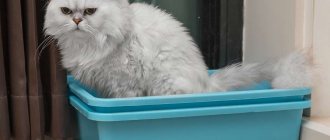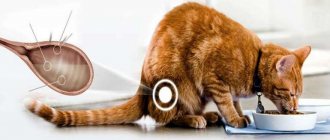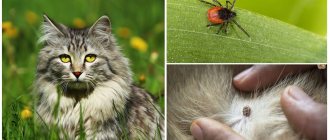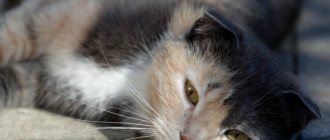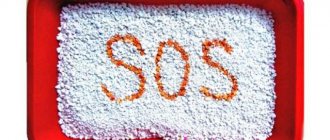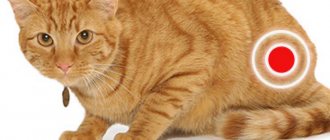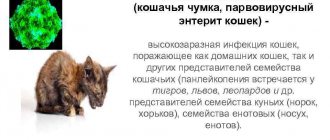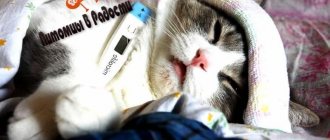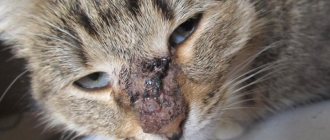Urinary cylinders
Precipitates without a specific structure. They are formed from exfoliated tissue elements, blood and inflammatory cells, and a large amount of matrix substance. Crystalline components are not always present in urinary cylinders. If they are found in mineral components, they are often formed by struvite. Uroliths and casts are physically different and occur for different reasons and are more often found in males than females. The urethra is narrower in cats and urinary cylinders can cause partial or complete obstruction. Idiopathic cystitis is one of the factors contributing to the formation of urinary casts.
In case of obstruction of the urinary tract by urinary cylinders, it is necessary to eliminate the obstruction of the urinary tract and restore urine flow, restore the acid-base balance of the body, the balance of fluids and electrolytes.
Causes
All forms of bladder inflammation in cats have similar symptoms, but their causes are different. Based on this, cystitis is divided into:
- Bacterial, known as a urinary tract infection (UTI).
- Idiopathic (ICC) or sterile. The most common of all types. It accounts for 60-65% of cases.
- Contact or calculous.
In bacterial cystitis, the source of inflammation is most often representatives of the natural microflora that live on the cat’s body: Escherichia, Staphylococcus, Proteus, Streptococcus. Bacteria can penetrate through the descending route from the kidneys, and through the ascending route - from the urethra.
The cat's body has protective mechanisms:
- Normal flora that suppresses pathogenic microorganisms.
- Urea in urine has an antibacterial effect.
- Complete and timely emptying flushes out bacteria and prevents them from ascending through the urethra into the bladder and flushes out those that have already penetrated.
- The bladder epithelial cells themselves prevent bacteria from sticking.
When these defense mechanisms are disrupted, infection begins. The consequence of this is a number of factors:
- Anatomical abnormalities or dysfunctions of the bladder that cause urinary stagnation. Therefore, bacteria that have entered the organ are not washed out.
- Damage to the urethra and urinary mucosa (trauma during catheterization, the presence of stones).
- Hypothermia. Occurs in animals that like to spend time on a tiled floor, a windowsill with an open window, or in a draft.
- Inflammation can be a consequence of pyelonephritis, urolithiasis, endo- and ectoparasites. Sometimes it develops with rhinotracheitis, chlamydia, or calcevirus infection.
- Endocrine diseases, primarily diabetes, predispose to infection.
- Chronic renal failure.
- Obesity, sedentary lifestyle, which is led by older cats and castrati.
The bacterial form occurs mainly in older animals and is often asymptomatic.
Idiopathic | feline interstitial cystitis
An inflammatory non-infectious psychoendocrine disorder, the pathogenesis of which involves the hypothalamic-pituitary-adrenal part of the endocrine system and the central nervous system.
Cats can be born with this predisposition and under certain stressful conditions this disease manifests itself. FIC is a chronic disease that is mild and resolves spontaneously. Relapses are common due to stressful situations. In sick cats, there is a decrease in the size of the adrenal glands.
Cats with idiopathic cystitis are often aggressive, nervous, and fearful.
FIC affects cats under the age of 10 years, without health problems; more often the animals eat only dry food. The relative density of urine is significantly increased in a large number of animals.
Hemorrhagic cystitis - drops of blood are present in the urine.
Calculous cystitis – sand, stones are deposited in the bladder.
Bacterial cystitis is characterized by the presence of bacteria in the urine; normally, urine is bacteria-free and sterile.
Scheme reflecting the proposed pathophysical changes in cats with idiopathic cystitis
How to treat idiopathic cystitis
The main thing is to eliminate stress factors affecting the sick animal.
Irritants:
- Inconvenient location of the toilet;
- Owner's daily routine;
- Change of weather;
- Low mobility of the cat;
- Food;
- Type of filler;
- Strangers and animals in the house.
How to mitigate the effects of stress:
- High complexes for cats;
- Toys that can be chased;
- Various devices for the manifestation of instincts.
Nutrition plays an important role in the pathophysiology and treatment of interstitial cystitis. Sudden and frequent changes often lead to relapses of the disease. The clinical condition of cats improves wet food, reduces the relative density of urine.
A diet with a very low pH is not recommended for cats suffering from FIC, because a decrease in urine pH leads to an increase in the level of irritation of nerve receptors located in the bladder, which creates a feeling of pain in the cat.
Diagnosis of feline cystitis
The following procedures help make a diagnosis:
- Veterinary examination. The doctor assesses the general condition of the animal and collects anamnesis. Palpation of the lower abdomen is mandatory.
- General blood analysis. The veterinarian should pay attention to the level of white blood cells and hemoglobin. Changes in these indicators are indirect signs of feline cystitis.
- General urine analysis. Aimed at identifying leukocytes, casts and epithelial cells. The presence of red blood cells indicates the presence of a hemorrhagic form of cystitis.
- Urine culture. Helps determine the type of infectious agent and its sensitivity to antibacterial agents.
- Blood chemistry. Aimed at identifying metabolic disorders that can provoke inflammation of the bladder.
- Ultrasound. Helps determine the type of inflammatory process and the severity of pathological changes in the mucous membranes. Ultrasound is also used to identify tumors in the organs of the excretory system.
Urine stones | uroliths
They are formed from poorly soluble crystalloids in the urinary tract. Visible to the naked eye - uroliths, detected under a microscope - are called crystals.
When urine is oversaturated with certain inorganic compounds, urinary crystals form. These compounds begin to precipitate as supersaturation increases. Urinary stones begin to form with the formation of their crystalline core. The growth of crystals depends on the duration of urine supersaturation, the ability of the urolith core to remain in the urinary tract, and the physical ultrastructure of the crystals. A number of factors influence the growth rate of uroliths: their mineral composition, the presence of infectious agents in the urinary tract, etc.
Relative supersaturation of urine
The main reason for the formation of crystals in the urinary tract is oversaturation of urine. Crystallization potential determines the level of relative supersaturation of urine.
The level of relative supersaturation of urine created by each type of crystal is specific.
Three states of urine saturation:
- Undersaturation;
- Metastable saturation;
- Oversaturation.
Relative supersaturation of urine
To assess the risk of urolith formation in the patient’s urinary system, each of them has special significance. A higher RSS of urine means a higher risk of crystal formation, and with a low RSS the risk of urolith formation becomes less significant.
Assessing the risk of struvite urolith formation based on RSS level
Assessment of the risk of calcium oxalate urolith formation based on RSS level
Stimulation of diuresis
The easiest and most effective way to treat all forms of FLUTD is to increase urine volume and stimulate diuresis. With a large volume of urine, the animal urinates frequently, which helps remove formed crystals, protein-containing material and cellular debris from the urinary tract. Diluting urine, accelerating its flow, has a beneficial effect on cats with urinary plugs and urinary tract.
To stimulate diuresis, your pet should drink more.
How to increase your cats' water intake:
- Increase the amount of canned or dry food intended to stimulate diuresis in the animal’s diet;
- Feed the animal often, but in small portions;
- Provide the animal with access to water at any time;
- The water bowl should be wide and fill to the brim;
- Give animals different types of water: filtered, distilled, bottled, warm running, cold running;
- Don't sweeten the water: cats don't have taste buds that recognize sweets;
- Adding fragrances to water. A number of companies produce various aromatic additives for drinking water to stimulate its consumption;
- Some cats prefer running water (drinking fountain);
- It is important to keep the water bowl a good distance from the cat's litter box;
- Some cats prefer glass bowls, others prefer ceramic or metal;
- Generally, cats do not like to share their bowl with other animals (especially dogs).
The more often a cat is fed per day, the more the pet drinks.
If the feed is of reduced digestibility, then water loss with feces increases. Cats with FLUTD should be given a highly digestible diet to reduce water loss through feces.
Increase the sodium content in the diet to increase the cat's water intake and dilute the urine.
Adjusting urine pH
Acidification of urine significantly increases the solubility of struvites and is quite sufficient for the dissolution of this type of uroliths. In contrast, alkalinization of urine is important for increasing the solubility of metabolic uroliths, including some urate and cystine urinary stones. It is not recommended to increase urine pH to more than 7.5, as this may cause the development of calcium phosphate uroliths. Calcium oxalate uroliths form in urine at any pH, and, as far as is known, there are no effective medications that can ensure their dissolution.
Caring for a cat with cystitis
Caring for a cat with cystitis will help you achieve positive results faster. But it will not replace competent and comprehensive treatment of a cat with an inflamed bladder.
The house should be warm. But under no circumstances warm the cat itself. Otherwise, it will only worsen the pet’s well-being. The fact is that if you warm a cat, pathogenic microorganisms in the bladder will begin to actively multiply. And the goal of treatment is to destroy them. Just try to make sure there are no drafts in the house and the floors are warm. Ideally, give the cat a bed with high sides or set up a house so that a cold breeze does not blow from anywhere.
Review your diet. Ideally, switch to ready-made food immediately. There are special ones - preventative against diseases of the genitourinary system. All the elements are there in perfect proportion. Just don’t choose cheap food, but high-quality, professional food, so to speak.
Struvite, risk factors, treatment
Struvite uroliths form when urine becomes oversaturated with magnesium, ammonia and phosphate, and its pH rises to more than 6.5. The solubility of struvite crystals increases at urine pH below 6.5, and at a level of 6.3 struvite stops crystallizing altogether. However, the pH value of urine decreases if animals are fed a diet that promotes increased diuresis and decreased urine concentration (wet food).
Magnesium. Diets containing 0.15-1.0% magnesium (dry matter basis) were associated with the formation of struvite urinary stones in cats. However, the degree of influence of magnesium depended on the form of its compounds and on the pH of the urine.
Phosphorus. With a diet high in phosphorus (3.17-4.70 g/1000 kcal), the incidence of struvite urolithiasis in cats was almost four times higher than in animals fed a diet with a phosphorus concentration of 0.85-1 .76 g/1000 kcal. A high level of phosphorus consumption is accompanied by a more intense excretion in the urine and, as a result, induces its oversaturation with magnesium, ammonia and phosphates.
Treatment
Relief of urinary tract infections. To treat cats, it is necessary to combine dietary therapy with the use of antimicrobial drugs.
It is possible to achieve the dissolution of urinary stones formed by struvite using diet therapy. For this purpose, a diet is used that provides an increase in the volume of urine excreted and a decrease in its pH to a level of 6.3 or less. Such a diet allows you to control the animal's magnesium intake and ensures that the RSS of urine is maintained below unity (the unsaturation zone). It must contain sodium in such an amount that the animals consume more water and produce unconcentrated urine. Sterile struvite uroliths do not require additional antimicrobial therapy.
Prevention of recurrence of urolithiasis. The recurrence rate of struvite urolithiasis in cats is 2.7% with an average duration of remission of 20 months. Therefore, after dissolution or mechanical removal of uroliths, special diets are recommended for cats. This type of preventive diet should maintain urine RSS in areas of unsaturation or metastable saturation, lower urine pH to 6.5 or less, contain plenty of moisture (canned food or other wet foods), and promote increased diuresis (due to increased sodium chloride).
X-ray of the abdominal cavity, the arrow shows a large single urolith
Struvite uroliths from the bladder
Struvite uroliths of various types
Internal factors
External causes of urolithiasis:
- Nutrition. The predominance of foods high in magnesium, phosphorus, calcium and sodium in the diet increases the risk of developing the disease. Excess protein foods and water with a high content of calcium salts contribute to an increase in the acidity of urine.
- Climatic conditions. A hot climate affects the formation and excretion of urine, diuresis decreases, and urine becomes more concentrated. Improperly organized drinking regime increases the risk of developing urolithiasis.
- Deficiency of retinol and B vitamins.
- Weak animal activity. Breeders overindulge their ward, the predator becomes lazy. Stagnation of uric acid forms in the blood entering the urethral system.
READ How often should a cat go to the toilet
New breeds imported from other countries are more susceptible to the disease.
In cats, 45% of uroliths consist entirely or partially of struvite (a salt of phosphorus and magnesium). Most stones form in sterile urine.
Endogenous causes of ICD:
- Infectious diseases. The formation of struvite uroliths (phosphates) is often associated with urinary tract infections caused by Stafhylococcus and Proteus bacteria. When pathogens enter the body, urease increases the concentration of ammonium in the urine, which leads to an increase in urine pH.
- Idiopathic hypercalcemia is an increased level of calcium in the blood. When plasma is filtered in the glomerular apparatus of the kidneys, calcium accumulates in the form of deposits.
- Obesity. With excess body weight, metabolic processes are disrupted, lipid processes in particular. Your furry friend develops the risk of developing other pathologies that impair diuresis.
- Violation of oxalic acid metabolism. The substance combines with calcium cations to form oxalates. With excessive acid excretion, the poorly soluble salt does not have time to be excreted and accumulates in the form of stones.
- Benign and malignant tumors.
- Developmental defects or acquired anatomical defects.
Be sure to read:
Kidney diseases in cats: types, what affects the appearance, symptoms, diagnosis, how to treat
Pets with a genetic predisposition are at risk.
Calcium oxalate
The average age at which most cats are diagnosed with urolithiasis is 7.8 years (but it can occur in animals between 2 and 18 years of age). The risk of calcium oxalate uroliths increases in older animals.
Most often, this type of urolithiasis affects males (55%) - in females, calcium oxalate urinary stones are found approximately 1.5 times less often.
Burmese, Himalayan and Persian cats have a predisposition to the formation of calcium oxalate uroliths, which suggests the existence of genetic factors that contribute to the development of this type of urolithiasis. Keeping cats exclusively indoors is an additional risk factor for the development of calcium oxalate urolithiasis.
Calcium oxalate uroliths
Effect of metabolic acidosis on urinary calcium excretion
Under conditions of metabolic acidosis, the release of calcium phosphate and carbonate from bone tissue is stimulated, which enter the blood, where they perform buffering functions. Excess calcium is excreted in the urine, which increases the risk of calcium oxalate uroliths.
Treatment and prevention of relapses
Calcium oxalate uroliths are not amenable to drug treatment. Therefore, urinary stones found in the bladder must be removed mechanically - by washing them out of the urinary tract with water under high pressure or surgically.
You should avoid dry foods that are not intended to reduce urine pH, as well as medications that increase the excretion of calcium from the body in the urine (urine acidifiers, furosemide, and others). Such cats should not be given treats or food additives containing calcium, vitamin D or vitamin C in increased quantities, as they increase the excretion of calcium and oxalates in the urine.
Formulate your cat's diet to maintain a urine pH of 5.8-6.2, thereby ensuring a low (below 5) RSS of urine calcium oxalate. It is necessary to ensure that cats consume more water - this is the main factor in the treatment and prevention of calcium oxalate urolithiasis.
Treatment approaches for localization of urinary stones in the kidneys and ureters
Removing urinary stones from the kidneys surgically (nephrectomy) entails the inevitable loss of nephrons. Therefore, this method of treatment is not recommended until it becomes clear that the uroliths located in the kidney are indeed causing serious illness in the animal. The indication for dissection of the ureter in order to remove uroliths from it is the progressive development of hydrocele of the renal pelvis. The operation is performed only if there is indisputable evidence that urinary stones are localized in the ureter. After such surgery, cats may experience complications such as urine accumulation in the abdominal cavity and ureteral stricture. An alternative to surgical treatment is conservative therapy.
Causes of cystitis
Urolithiasis is a severe pathology that develops for many reasons.
Its formation is influenced by both internal and external reasons. The growth of the disease is associated with changes in the living conditions of animals. Pets are given dry food of poor quality, limited space, and the predator moves little. The causes of cystitis in cats are very diverse. And all because inflammation in the bladder (namely, it is called cystitis) can be either a primary (independent) or a secondary disease (a symptom of another, for example, infectious). The problem is that if a cat has had cystitis at least once, it will return at the slightest draft or decreased immunity. So let's figure out where this sore comes from so that your pet never suffers from it.
Hypothermia
The most common cause of cystitis in cats is hypothermia. It's the same with people. You just sit somewhere in the cold, lie down, walk in cold weather (especially in the rain) - and that’s it. Inflammation is “guaranteed.” And if your pet’s immune system is weakened, then the risk is even greater. Therefore, you should not allow the mustache to sleep or just lie/sit on a cold floor (for example, on tiles, concrete).
Cystitis often develops in a cat due to excessive proliferation of pathogenic bacteria in the bladder itself. Sometimes the inflammation “descends” from the kidneys or “rises” from the urethra. Inflammatory processes of the organs of the genitourinary system very quickly, as if in a chain, affect everything: the kidneys, bladder, ureters, urethra. It is necessary to start treating your cat for cystitis on time, otherwise there will be a lot of health problems later.
Many diseases (viral, bacterial) lead to inflammation in the bladder, although at first glance the animal only has a cough or lacrimation. It is necessary to diagnose cystitis in a cat in time and begin complex treatment immediately (using traditional methods and always medication).
Chronic diseases
Some owners don’t even realize that their animal has health problems. They do not visit the veterinarian for the purpose of medical examination of the pet, so inflammation occurs latently in the body for a long time. And they have the “property” of “moving” from one organ to another (bacteria are spread throughout the body through the bloodstream). Therefore, you should not leave your mustache without treatment. No matter how trivial an illness or cold may seem to you. Complications can be serious.
This reason may include urolithiasis and obesity resulting from metabolic disorders. Also, poor quality of food and water can cause the development of cystitis in cats. Underfeeding and overfeeding also greatly change metabolism, and not for the better. What causes urolithiasis to develop? Urine does not pass well and stagnates. The bladder becomes inflamed, and pathogenic microorganisms in stagnant urine multiply very quickly.
All this leads to cystitis. Restricting access to water will only make the situation worse. Water helps cleanse the bladder and reduces the concentration of bacteria. The more often the cat runs around, the greater the chances of his speedy recovery (of course, if you use medications prescribed by the veterinarian).
This may include stress, abdominal/back injury.
Calcium phosphate uroliths
The cat is examined for the presence of high concentrations of calcium and/or phosphate in the urine, hypercalcemia, primary parathyroidism, and alkaline urine (pH > 7.5). If the patient’s primary disease could not be diagnosed, against the background of which calcium phosphate urolithiasis developed, then they resort to a treatment strategy similar to calcium oxalate urolithiasis. However, the necessary precautions should be taken to prevent an excessive increase in urine pH, which often happens when a cat receives special food intended for the treatment of calcium oxalate urolithiasis.
Treatment of a cat for cystitis
how to treat a cat for cystitis? Some people immediately begin to study forums in search of traditional methods of treating a cat for cystitis, others ask neighbors and friends. Most people start treatment with the drug stop cystitis, but the fact is that the drug only relieves symptoms, but does not eliminate the root cause.
- Antibiotics are most often prescribed. Even if bacteria are not the culprit, sooner or later pathogenic microorganisms attack the inflamed area. Without them, it is unlikely that it will be possible to achieve a full recovery. Ask your veterinarian to test the sensitivity of bacteria in the urine to antibiotics to avoid giving your pet medications that will not help him.
- To prevent antibiotics from leading to dysbiosis, a qualified veterinarian will prescribe probiotics (drugs that restore intestinal microflora). Only they should not be given immediately after or before the administration of antibiotics. Otherwise, probiotics will be of no use.
- Antispasmodics. They will help the animal “relax” a little. Firstly, the cat will be able to pee (it won’t hurt as much, and the inflammation will decrease a little). Secondly, this will allow the cat to excrete more urine at one time, it will not stagnate.
- Be sure to eliminate the cause! If this is a metabolic disorder, then completely review your diet and be sure to filter the water. If ICD has already developed, then you need to deal with it. If other chronic diseases are the cause, then they are eliminated.
- If a cat has idiopathic cystitis, then it is very difficult to treat. The whole problem is that, as stated above, the reasons for its occurrence have not yet been discovered. Therefore, the veterinarian has to prescribe symptomatic treatment (for example, stop cystitis, diuretics, antibiotics).
READ Ringworm Symptoms and Treatment in Cats
Urolithiasis is a multifactorial systemic disease. Treatment involves a complex set of therapeutic measures. They are determined by a veterinarian based on diagnostic results. The method is selected individually depending on the degree of damage, age, and general condition of the pet.
Animals need both conservative and surgical methods of therapy. The success of treatment is largely determined by the timeliness of measures taken.
Urate uroliths
These uroliths consist of uric acid and the monobasic ammonium salt of uric acid (ammonium urate). Urates are found less frequently (<6%) than struvite and calcium oxalate.
Formed in animals with portosystemic anastomosis and in various forms of severe liver dysfunction, they usually contain struvite.
Urate urinary stones
Urate uroliths occur:
- for urinary tract infections accompanied by an increase in the concentration of ammonia in the urine;
- with metabolic acidosis and highly alkaline urine;
- when receiving a diet rich in purines (made from liver or other internal organs).
How to recognize the disease
The main symptoms of cystitis are associated with changes in the volume and color of urine in cats. Manifestations of pathology:
- The cat often visits the litter box, but little urine is released, sometimes drops. It can sit for a long time, but without results.
- Possible urinary incontinence.
- Going to the toilet in an unusual place. The cat leaves puddles in front of the owner's eyes. He tries to draw attention to his problem. And the litter box may be associated with pain, so the animal avoids it.
- Urine changes color due to blood or pus and becomes cloudy. The smell becomes ammonia-like.
- The cat is restless. In the process of urination it makes plaintive sounds. The animal's movements are very careful because of the pain in the area of the inflamed organ. The pet does not allow his belly to be touched.
- The animal often licks its genitals to make it easier to go to the toilet.
In severe cystitis, urination may be completely absent. A pet in this condition refuses to eat and becomes lethargic. Possible increase in body temperature. If treatment measures are not taken, coma may occur.
The symptoms of bladder inflammation are the same as the signs of urolithiasis, so it is unacceptable to start treating yourself at home.
Differential diagnosis
At the first signs of cystitis in cats, the following diagnostic measures are necessary:
- Ultrasound. Helps to assess the volume of the bladder, identify wall deformations and determine the presence or absence of stones. They also look to see if there are changes in the kidneys.
- Urine culture test to identify infectious agents (streptococci, chlamydia, etc.) and their resistance to antibiotics. To choose the right course of drugs, the doctor takes material directly from the bladder through a puncture of the peritoneum (cystocentesis).
- General urine analysis. Blood, pus, and salt crystals may be detected.
- A blood test to evaluate the functioning of internal organs, primarily the kidneys.
Before diagnosing cystitis, your doctor will need to rule out conditions such as urinary incontinence, neuralgia, or possible behavioral problems.
If after diagnosis the causes of urinary inflammation in a cat are not revealed, a conclusion is made - idiopathic cystitis.
Cystine uroliths
Cystine uroliths are formed in cats with cystinuria, which occurs as a congenital disorder of the reabsorption of cystine and other amino acids (ornithine, lysine, arginine) in the proximal tubules of the kidneys. In most cases, cystine uroliths are found in aging cats.
Small cystine uroliths can be removed from the urinary tract by flushing it with high pressure water. Large urinary stones must be removed surgically (through cystotomy).
Electron microscopy image of cystine urolith
Reduce the content of methionine and cystine in the diet while using drugs containing thiol.
Alkalinization of urine. The solubility of cystine depends on the pH environment; it increases in alkaline urine. You can increase the pH of urine by using a diet containing potassium citrate or by giving animals this drug orally.
Signs of urolithiasis in cats
Symptoms of the pathology depend on the location of the stones:
- Disruption of the urination process. The presence of sand in the lower urinary tract obstructs the flow of urine.
- Vomiting is caused by ureteral obstruction.
- Pain in the kidneys - the animal cannot touch the abdomen; it occurs when the kidney capsule is blocked.
- Pain when urinating – the pet often goes to the litter box, meows during the deurination process. Such manifestations are typical for urethral stones.
- The appearance of blood stains in the tray is associated with damage to the ureteral mucosa by microscopic crystals (sand).
- A swollen, dense abdomen is observed with urocystolitis.
Clinical signs of nephroliths may not appear until 2/3 or more of the renal parenchyma is lost.
Xanthine uroliths
They are rare. The formation is associated with a congenital disorder of purine metabolism, or they are formed as a result of cats receiving allopurinol orally.
Diet therapy strategy: reducing the purine content in the diet, high water consumption, giving wet food.
Treatment of uric acid with allopurinol should be stopped immediately - the drug promotes the formation of xanthine uroliths.
Xanthine urinary stones
Silicate uroliths
Silicate uroliths are rare in cats and this pathology is recorded in cats more often than in cats. There is a definite relationship between the incidence of this type of urolithiasis in cats and the use of plant-based foods (large amounts of fiber or bran). Cats need to be given more to drink.
Silicate urinary stone
Uroliths formed by dense blood clots
Prevention of urolithiasis in cats
The basis of prevention is the organization of proper nutrition. The pet's diet must be balanced. Avoid monotony and overfeeding. Feed is selected carefully, focusing on the health status of the predator.
They monitor the drinking regime and control deurination. Regularly scheduled medical examinations are carried out. To prevent relapses, 2-4 ml of CotErvin are administered daily for a week.
Preventing cystitis in cats is not as difficult as you might think.
- First of all, prevent drafts in the house. The animal should not become hypothermic, cold, or wet during a walk.
- Then be sure to plan your diet correctly so that everything is in accordance with the norms. There should not be only protein feeding. In general, the prevention of urolithiasis in cats is ideal here.
- Vaccinations. They will help develop immunity to certain pathogens (bacteria and viruses), which will significantly reduce the risk of bladder inflammation in your cat.
- Avoid injury. Your pet should not jump at heights like a monkey. If the mustache does get hit, then take it to the veterinarian. In addition to cystitis, there may also be internal bleeding and organ rupture.
- Less stress. Try to make your cat's life as calm as possible.
- Drinking water must always be available! And not from the tap, but well filtered so that there are no salts or impurities in it. Don't limit the amount of water you drink. The more a cat drinks clean water, the better the kidneys and bladder are cleansed. However, sometimes increased thirst is a symptom of a serious illness (for example, diabetes).
READ Why does a dog drag shoes? The cat peed in your shoes, how to get rid of the smell of urine if the cat marked your shoes
The drug “Stop Cystitis” is widely used for the treatment of cats. Most often prescribed to animals with inflammatory processes of the genitourinary system (acute or chronic). It is available not only in tablets, but also in suspensions, which are much easier to give to a sick animal.
If the drug is used specifically for the purpose of treatment, it is given twice a day until complete recovery occurs. If the veterinarian advised you to give it to your mustache for the purpose of prevention, then once is enough, and the course will be 5-7 days.
If you have any questions about cystitis in cats, ask them in the comments. We will definitely try to help you!
Complex uroliths
Consist of a core formed by one type of mineral and a stone or shell formed by another type of mineral. They are formed in cases where factors first act to promote the crystallization of one mineral, and then conditions arise under which crystallization of another mineral occurs. Some types of minerals may also function as a core upon which further deposition of other inorganic substances occurs. All types of uroliths contribute to the development of urinary tract infections, which, in turn, accelerate the precipitation of struvite.
Complex urolith. The core consists of acid ammonium urate, the shell is made of struvite
The dietary therapy strategy is to eliminate factors that contribute to the formation of complex urinary stone nuclei. It is recommended to give sick cats wet food or add water and sodium to it: this helps reduce the saturation of urine with components from which uroliths are formed.
Treatment of urolithiasis with folk remedies
Treatment at home without a correct diagnosis is risky; you should find out the type of stones. At home, you can safely only stimulate diuresis.
If the composition of urinary stones is not known:
- Dandelion root is a strong diuretic. Collect dandelion roots in the fall, after the first frost. Without peeling off the black skin, rinse with cold water and dry in the open air for four days. Then cut and dry. Take a 0.5 liter jar, fill ¼ of the jar with dandelion root, add hot water, leave for 14 days. The cat should be given before meals: add 6-9 drops of infusion to a tablespoon of water, give 3-4 times a day, course 7 days;
- The rice loosens and removes stones. Pour 1 liter of cold water over 2 tablespoons of rice overnight. In the morning, rinse the rice in a colander, add 1 liter of cold water, bring to a boil and cook, stirring for 7 minutes. Then drain the rice into a colander and pour boiling water over it. Rice is given to the cat in the morning on an empty stomach; you can feed it the usual diet after 2 hours. Rice removes calcium, so you need to give calcium tablets for cats or cottage cheese, milk;
- Celery – anti-inflammatory, wound healing effect. Celery root and greens are passed through a blender or meat grinder. Mix 0.2 kg of celery with 0.2 kg of honey. Leave in the refrigerator for 10 days. The cat is given 0.5 - 1 teaspoon 3 times a day.
If the composition of urinary stones is known, then use the following:
- Phosphorus stones. Mix 5 parts licorice root, 5 parts horsetail, 4 parts motherwort, 4 parts St. John's wort, 3 parts birch buds, 9 parts bearberry, 4 parts peppermint, 4 parts juniper, 4 parts yarrow, 3 parts rose hips, 9 parts buds. pears, 9 parts of lingonberry leaves. Pour 1 tablespoon of the mixture into 200 ml of boiling water. Give the cat 1 tablespoon before meals 4 times a day, course 7 days;
- Pyelonephritis due to urolithiasis. Mix 2 parts curly parsley, 2 parts strawberry herb, 1 part St. John's wort, 1 part juniper fruit, 2 parts horsetail, 2 parts bearberry, 2 parts knotweed. Pour 1 tablespoon of the mixture into 200 ml of boiling water. Give the cat 1 tablespoon before meals 4 times a day, course 7 days;
- Oskolate and urate stones. Mixtures are used. The first is 1 part rose hips, 2 parts knotweed, 1 part wheatgrass rhizome, 1 part flax seeds, 1 part corn stalks with stigmas, 1 part strawberry leaves, 6 parts tops of oat inflorescences. The second is 2 parts of dill seeds, 3 parts of bearberry leaves, 2 parts of Chernobyl, 3 parts of carrot seeds. Pour 1 tablespoon of the mixture into 200 ml of boiling water. Give the cat 1 tablespoon before meals 4 times a day, course 7 days;
- Phytotherapy. For 7–14 days, give 0.5 teaspoon of fresh knotweed juice 3 times a day, immediately wash it down with fresh milk. Knotweed is effective against stones in the gall bladder and bile ducts. Contraindicated in old animals;
- Grate 1 kg of carrots, place in a container, add 1 kg of raisins. Pour in 14 cups (200 ml) water. Place the container in a water bath and cook for 4 hours over low heat. Strain the juice. People take 1 tablespoon 3 times a day 30 minutes before meals, pets – 1 teaspoon. Course 14 days.
Therapeutic measures
Already at the first manifestations of bladder inflammation in a cat, the owner must take action. In an advanced state, healing is a long process.
Treatment of cystitis in cats depends on the form and type of the disease. The main thing is to eliminate the cause, and not limit yourself to treating symptoms.
Treatment uses a combination of various drugs, which is determined by the doctor.
Bacterial cystitis in cats is a treatable disease, but due to its serious consequences it is the most dangerous.
A urinary tract infection can be treated at home. But this does not mean that the cat owner should choose the medicine. The main goal is to destroy the causative agent of cystitis. Antibiotics are prescribed for this. These could be pills or injections.
The doctor can make the first appointment without waiting for test results. Then adjust the treatment.
Only for the idiopathic type of cystitis, therapy consists of eliminating symptoms (incontinence and sudden urges to urinate). Features of therapy and care for ICC:
Treatment of urolithiasis by veterinarians
Algorithm | treatment regimen. Painkillers, antispasmodics, antibiotics (dosage).
Veterinarian treatment regimen for urticaria, injections, tablets, dosage of medications: no-spa, papaverine, baralgin, prazosin, terazosin, glutargin, glucose, Ringen-Lock solution, Vetavit, nitroxoline, furadonin, endrofloxacin, etamsylate (dicinone), vikasol
Treatment of urolithiasis, dosage of drugs and how to take: stop cystitis, uro-ursi, urotropin, cystokur forte, furinaid, ipakitine, cantaren, kotervin, nephrocat, renal advance, himalaya cyston, urolex, healthy kidneys phytoelite
Prevention
The main prevention of cystitis in cats comes down to the following measures:
- Protect the animal from hypothermia.
- Provide a balanced diet.
- Treat against parasites.
- Get comprehensive vaccinations annually (against rhinotracheitis, panleukopenia, calicivirus, rabies).
- Make sure your pet is not stressed. If this cannot be avoided (moving, transportation), it is recommended to use sedatives.
- Make sure that the cat is satisfied with the tray, the place where it stands and the filler.
- Control weight and try to get the animal to move more.
To prevent relapses of cystitis, your veterinarian may prescribe food supplements, antidepressants, and anti-spasm medications.
